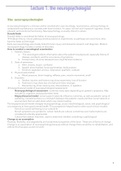The neuropsychologist
A neuropsychologist is a clinician and/or scientist who uses neurology, neuroscience, and psychology to
understand how behaviors correlate with brain function. To asses ‘normal’ and ‘impaired’ cognitive, social,
physical, and emotional functioning. Neuropsychology is usually clinical in nature.
Donald Hebb
Donald Hebb is considered the father of neuropsychology:
à Hebbian theory: neural pathways develop based on experiences; as pathways are used more, they
become faster and stronger.
Early neuropsychology was closely linked to brain injury and dementia research and diagnosis. Modern
neuropsychology includes a variety of disorders.
How to conduct a neurological examination
1. Patient’s history:
a. The neurologist collects information about the patient’s background, especially history of
disease, accidents, and the occurrence of symptoms.
b. Family history à some diseases have a high familial incidence
2. State of awareness
a. Alert, drowsy, stupor, confused
b. Speech abnormalities, facial asymmetries, body posture
c. Emotions (agitated, anxious, depressed, apathetic, restless)
3. Physical examination
a. Blood pressure, brain imaging, reflexes, pain, muscle movement, smell
4. Disorders
a. Strokes, injuries, and lesions may show asymmetry, loss of function
b. Parkinson’s may show loss of smell and motor changes
c. Dementia may show memory loss, disorientation, or agitation
à biopsychosocial model of neuropsychological assessments
- Neuropsychological assessment: combines many tests depending on patient’s symptoms. May
include IQ, cognitive, and psychometric tests
- Biopsychosocial model: social support networks influence outcomes, as well as patients’ sense of
wellbeing. Sometimes there is a mismatch between the patients’ needs and their social network or
environment that can add stress which may impair healing.
The biopsychosocial model changed neuropsychology, as you need biological, social, and psychological
circumstances to have good mental health. This perspective helped lead to other social-clinical models:
- Part of our social well-being is our cultural fit
- Not all symptoms are symptoms: certain beliefs are cultural, sometimes even hallucinations are
considered culturally appropriate
- Cultural formulation interview: used to determine whether something is pathological
Change as an assumption
Plasticity, flexibility, and adaptability are fundamental properties of the brain. These are all forms of change.
Change is an assumption of neuropsychology because without change there would be no rehabilitation, and
without this therapies would not work.
1
, How brain lesions led to modern understanding of brain function
and organization
Broca’s aphasia
Loss of grammatical structure, and difficulty forming words or sentences. Can be noticed in the clinic due to
brain lesions in frontal lobe. Often patients also have right-side weakness or paralysis due to lesion’s impact
on motor function.
Speech is hard to produce but usually not impossible. Other language functions, like understanding speech
and motor movements, as well as production of familiar songs, often remain intact.
Brain lesions
A brain lesion is an area of brain damage, which can result from a stroke, loss of blood flow, tumor, injury, etc.
It can be seen in a MRI scan as a white blob, due to reduced blood flow. Clinical cases of brain lesions led to
discovery that certain types of damage was consistent with certain types of symptoms:
- Localization: damage in a certain part of the brain à concluded that some brain functions were
anatomically located
- Lateralization: damage on a certain side of the brain à concluded that some functions were usually
on a specific side of the brain
- Distribution of function: lost functions are sometimes rehabilitated à concluded that other parts of
the brain can compensate
- Hierarchical organization: sophistication of functions vary depending on whether a higher or lower
brain area is damaged à brain processes start with lower levels and are processed through
increasingly higher levels. Sometimes the brain can compensate with lower regions.
Wernicke’s aphasia
Word salad. No understanding of spoken or written language. Fluent and rhythmical speech with intonation,
but without meaning. It looks like they are speaking a foreign language, it is fluent but doesn’t make any
sense. They have problems with:
- Recognizing the word code
- Derive word meaning
- Convert meaning to words
Anatomy the blood supply of the brain
Anatomical terms
2





